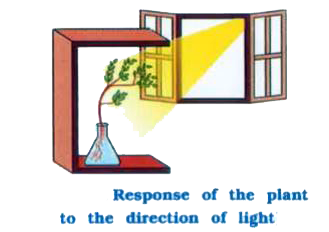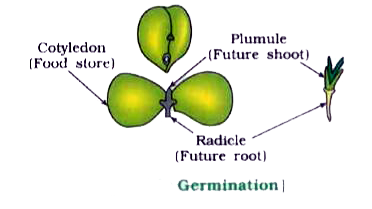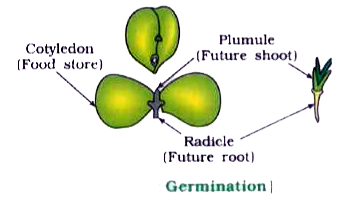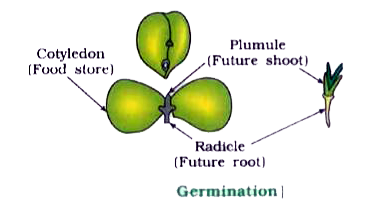To observe the response of plant parts to light OR To study phototropism in plants.
Materials : Conical flask, wire mesh, cardboard box open from one side, water, two- three freshly germinated bean seeds.
Procedure :
→ Fill a conical flask with water.
→ Cover the neck of the flask with a wire mesh.
→ Keep two-three freshly germinated bean seeds on the wire mesh.
→ Take a cardboard box which is open from one side.
→ Keep the flask in the box in such a manner that the open side of the box faces light coming from a window.
→ Observe after two or three days and note down your observation.
→ Now turn the flask and leave it undisturbed in this condition for a few days and then observe.

Observation : In the initial position of flask, the shoot bends towards light and roots turn away from light.
→ After turning the flask, position of shoot and roots change, i.e., shoot goes away from light and roots turn towards light but after a few days shoot again shows bending towards light and roots move away from light.
Are there differences in the direction of the new growth ?
No, growth pattern or direction follows environmental stimulus.
Topper's Solved these Questions
- CONTROL AND COORDINATIONBOOK - KUMAR PRAKASHANCHAPTER - CONTROL AND COORDINATIONEXERCISE - TEXTUAL EXERCISE
12 Videos
- CONTROL AND COORDINATIONBOOK - KUMAR PRAKASHANCHAPTER - CONTROL AND COORDINATIONEXERCISE - ADDITIONAL QUESTIONS AND ANSWERS
22 Videos
- HEREDITY AND EVOLUTIONBOOK - KUMAR PRAKASHANCHAPTER - HEREDITY AND EVOLUTIONEXERCISE - PRACTICAL SKILL BASED QUESTIONS WITH ANSWERS
5 Videos
Similar Questions
Which of the following is a plant hormone ? (a)Insulin (b)Oestrogen (c)Thyroxine (d)Cytokinin
View SolutionDistinguish between :
Response in Plants and Response in Animals
View SolutionYou are supplied with two sets of seeds of pea plants. One set is yellow and round seeds with gene constitution YYRR and other set is green and round seeds with gene constitution yyRR. From both sets of seeds plants are cultivated. Pea plant is self-pollinated but arrange artificial cross between two given plants cultivated from seeds. Which offsprings do you expect ? show with chart.
View SolutionWhy is some KOH placed in a small test tube in the flask with germinating seeds in the experiment to demonstrate occurrence of respiration in germinating seeds?
View SolutionA conical flask of height 24 cm is full of water . If this water is poured into another cylindrical flask of radius half of the conical flask , then how much water - level of the cylindrical flask will be raised ?
View Solutionएक शंक्वाकार पलास्क पानी से भरा है। फ्लास्क के आधार की त्रिज्या तथा ऊँचाइ h है। यदि इस पानी को mr आधार की क्रिज्या वाले बेलनाकार फ्लास्क में डाला जाता है, तो बेलनाकार फ्लास्क में पानी की ऊँचाई ज्ञात कीजए।
View SolutionA conical flask is full of water. The flask has base radius r units and height h units, the water pured into a cylindrical flask of base radius xr units. Find the height of water in the cylindrical flask.
View SolutionA conical flask is full of water. The flask has base-radius r and height h . The water is poured into a cylindrical flask of base-radius mr . Find the height of water in the cylindrical flask.
View SolutionTo observe the response of plant parts to light OR To study phototropism in plants. Materials : Conical flask, wire mesh, cardboard box open from one side, water, two- three freshly germinated bean seeds. Procedure : rarr Fill a conical flask with water. rarr Cover the neck of the flask with a wire mesh. rarr Keep two-three freshly germinated bean seeds on the wire mesh. rarr Take a cardboard box which is open from one side. rarr Keep the flask in the box in such a manner that the open side of the box faces light coming from a window. rarr Observe after two or three days and note down your observation. rarr Now turn the flask and leave it undisturbed in this condition for a few days and then observe. Observation : In the initial position of flask, the shoot bends towards light and roots turn away from light. rarr After turning the flask, position of shoot and roots change, i.e., shoot goes away from light and roots turn towards light but after a few days shoot again shows bending towards light and roots move away from light. Have the old parts of the shoot and root changed direction ?
View SolutionTo observe the response of plant parts to light OR To study phototropism in plants.
Materials : Conical flask, wire mesh, cardboard box open from one side, water, two- three freshly germinated bean seeds.
Procedure :
→ Fill a conical flask with water.
→ Cover the neck of the flask with a wire mesh.
→ Keep two-three freshly germinated bean seeds on the wire mesh.
→ Take a cardboard box which is open from one side.
→ Keep the flask in the box in such a manner that the open side of the box faces light coming from a window.
→ Observe after two or three days and note down your observation.
→ Now turn the flask and leave it undisturbed in this condition for a few days and then observe.

Observation : In the initial position of flask, the shoot bends towards light and roots turn away from light.
→ After turning the flask, position of shoot and roots change, i.e., shoot goes away from light and roots turn towards light but after a few days shoot again shows bending towards light and roots move away from light.
What can we conclude from this activity ?
View SolutionTo observe the different parts of seed.
Materials : Seeds of Bengal gram (chana), water, wet cloth.
Procedure :
→ Soak a few seeds of Bengal gram (chana) and keep them overnight.
→ Drain the excess water and cover the seeds with a wet cloth and leave them for a day.
→ Make sure that the seeds do not become dry.
→ Cut open the seeds carefully and observe the different parts.

What is an embryo of plant ?
View SolutionTo observe the different parts of seed.
Materials : Seeds of Bengal gram (chana), water, wet cloth.
Procedure :
→ Soak a few seeds of Bengal gram (chana) and keep them overnight.
→ Drain the excess water and cover the seeds with a wet cloth and leave them for a day.
→ Make sure that the seeds do not become dry.
→ Cut open the seeds carefully and observe the different parts.

Which are the structures seen in an embryo?
View SolutionTo observe the different parts of seed. Materials : Seeds of Bengal gram (chana), water, wet cloth. Procedure : rarr Soak a few seeds of Bengal gram (chana) and keep them overnight. rarr Drain the excess water and cover the seeds with a wet cloth and leave them for a day. rarr Make sure that the seeds do not become dry. rarr Cut open the seeds carefully and observe the different parts. What is the role of cotyledon in chana ?
View SolutionTo observe the different parts of seed.
Materials : Seeds of Bengal gram (chana), water, wet cloth.
Procedure :
→ Soak a few seeds of Bengal gram (chana) and keep them overnight.
→ Drain the excess water and cover the seeds with a wet cloth and leave them for a day.
→ Make sure that the seeds do not become dry.
→ Cut open the seeds carefully and observe the different parts.

Which parts in seed are known as future root and as future shoot ?
View SolutionTo observe the different parts of seed.
Materials : Seeds of Bengal gram (chana), water, wet cloth.
Procedure :
→ Soak a few seeds of Bengal gram (chana) and keep them overnight.
→ Drain the excess water and cover the seeds with a wet cloth and leave them for a day.
→ Make sure that the seeds do not become dry.
→ Cut open the seeds carefully and observe the different parts.

How is an embryo formed from zygote ?
View Solution
